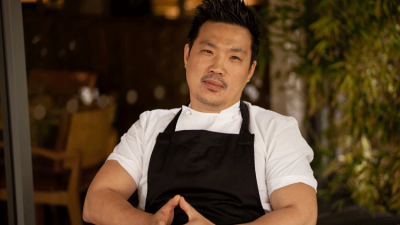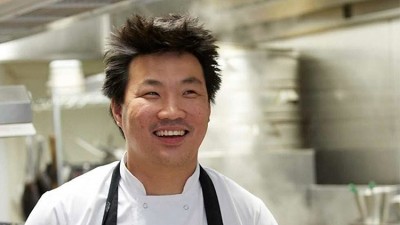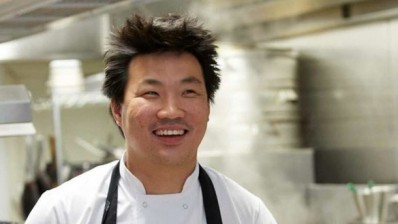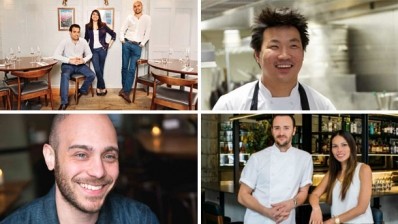Kid A: Andrew Wong on restaurant A.Wong
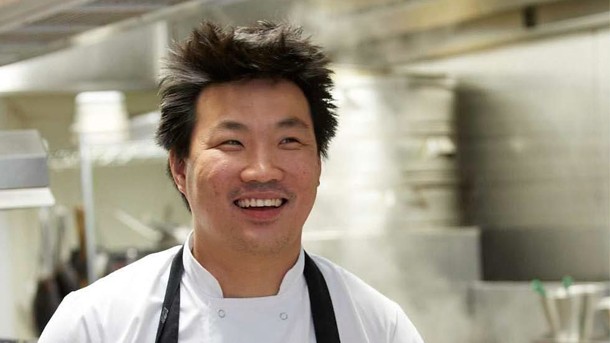
Chef Andrew Wong doesn’t expect many people to attempt the 14-step Peking duck recipe in his recently published cookbook. Those who do will need to block out two days in their diary and source a bike pump that they won’t mind getting covered in duck fat.
A.Wong The Cookbook also contains instructions for creating gossamer-thin dim sum wrappers from a fiendishly sticky dough, while the chef laughingly admits the hand-pulled noodles on page 177 could cause some to lose the will to live.
The book – and indeed Wong’s London restaurant – are there to showcase the scope and intricacy of Chinese cuisine. The fact that the entirety of his country’s vast culinary lexicon is still seen as unsophisticated hangover fodder by many is a source of great frustration for the 32-year-old.
“These are skills that are pretty much forgotten, at least in this country. They highlight how refined Chinese cooking can be when it’s done properly. Not all of our dishes can be thrown in a wok and served moments later,” says Wong, who also points out that wok cooking itself is a far more nuanced art than people give it credit for.
He is an unlikely spokesman for Chinese gastronomy. His family are in the hospitality business – his grandfather ran a prominent restaurant in Chinatown’s Gerrard Street and his parents owned a string of pubs in the East End before opening Kym’s in Victoria – but he was supposed to follow a more academic path.
“As a second generation Asian your instructions are to go and study and get a good job. Something impressive sounding like a doctor, a lawyer or maybe an investment banker,” he says.
Swapping law for food
Wong did as he was told. He aced his GCSEs and A-Levels, studied chemistry at Oxford, social anthropology at the London School of Economics and enrolled in law school. But his journey to a world far removed from the hospitality industry was cut short by the death of his father.
“I came back out of a sense of obligation. It’s pure luck I ended up loving cooking and restaurants,” says Wong, who swapped law school for a number of part-time courses at Westminster Kingsway catering college, which is just down the road from the family restaurant.
He balanced his studies with running Kym’s, a Cantonese veteran on Wilton Road a few minutes’ walk from Victoria Station. In common with nearly all of this country’s Chinese restaurants, Kym’s offered a large
menu of Cantonese-style dishes adapted for the UK market.
In late 2012 it reopened as A.Wong. Named after his parents – Albert and Annie – rather than Wong himself, the bright and modern restaurant is unrecognisable from its forebear.
A.Wong serves a much smaller à la carte of food from all over China alongside a 10-course ‘Taste of China’ menu and an eight-course Peking duck feast that needs to be ordered two days in advance. The menus showcase a mix of the familiar – there are takes on Cantonese restaurant classics such as sweet and sour chicken and crispy duck with pancakes – to constituents of the Chinese cooking canon that are virtually unknown in the UK.
There’s a salad of seared beef with mint, chilli and lemongrass which hails from Yunnan, a province in south-west China that borders Vietnam, and a pulled lamb ‘burger’ that arrives aggressively spiced with cumin and speckled with pomegranate that takes its cues from the predominantly Muslim region of Xinjiang in the north-west of the country.
Progressive Wok
The recipes are a result of several years’ research and development. “I went to catering college with the preconception that Chinese food wasn’t as refined as classical French cooking. This was reinforced during my time there. It’s only in the last five years or so that I’ve come to realise just how sophisticated Chinese cuisine can be,” he says.
Wong’s epiphany came over a bowl of wonton soup in Hong Kong. “That one dish made me understand Cantonese food,” he recalls. “The broth is based on a great stock but it’s also flavoured with shark fin, ground flounder powder and garlic chives. It’s completely balanced. The flavours are in perfect harmony.”
“Then there’s the wontons themselves,” he continues. “The wrappers that encase the minced prawn are made with high-gluten flour and duck eggs. To get the silky mouthfeel you need a firm dough that’s been worked hard, so chefs place it under a wooden board and jump up and down on it for hours. It looks like a very simple dish but if you want to make it properly it is hugely labour intensive.”
Learning recipes in China wasn’t easy. “There’s a certain mentality with Chinese chefs. They’re old school. They think they’re teaching you kung fu rather than cookery,” he says. “But we’re living in a different world now. Getting hold of recipes isn’t difficult, it’s the technique that’s hard to master. Once you’ve learnt that it all starts opening up. As I travelled round more provinces I started to be able to pick up on the thought process behind each food culture.”
Victoria's Secret
Wong’s indubitable skills as a chef, inquisitive nature and refusal to compromise – he relishes difficult-to-master preparations – has endeared his restaurant to diners and critics alike. The 42-cover restaurant – which Wong runs with his wife Nathalie – has had glowing reviews from many major critics, an achievement all the more impressive given its somewhat dubious location. Sandwiched between a discount fashion store and an all-you-can-eat Brazilian barbecue, A.Wong is in an area of Victoria that’s unlikely to benefit much from the regeneration project occurring closer to the station.
None of the kitchen kit from his parents’ restaurant remains in the kitchen – it was all purchased in the ’80s before the dawn of gas regulations. But Wong uses the same two pieces of kit to cook much of his menu: a huge dim sum steamer and a run of wok burners.
He does however also use equipment that would never be found in a traditional Chinese kitchen, including a combi-oven (if a Chinese restaurant had an oven at all it would be a bullet-shaped duck oven), a salamander grill, induction hobs, blast chiller and a waterbath.
As the kit hints, the cooking processes at A.Wong borrow from Western gastronomy, but Chinese techniques still dominate. Wong says his aim is to make Chinese cooking a little more modern and light without losing the complexities and idiosyncrasies of each recipe.
Most dishes incorporate a minor twist. Wong’s Shanghai soup dumplings (aka xiao long bao) are made in the traditional, hugely laborious way: minced pork belly and intenselypiggy pork stock is encased in a delicate skin that can just about withstand the journey from dim sum basket to mouth. These are usually served alongside Chinkiang vinegar, but Wong injects the jet black liquid into the dumplings at the pass.
“Traditionally people use the vinegar to cool the dumpling down, but I think that results in an overly acidic mouthful. The idea behind using a pipette was to get the balance of vinegar to dumpling absolutely right,” he says.
A.Wong’s fantastic version of gong bao chicken – a classic Sichuanese dish of chicken and peanuts that exemplifies the ma la (numbing and spicy) taste that is a hallmark of the province’s cuisine – has also been subtly tweaked, but most would not be able to identify exactly what had changed.
Wong makes a stock with the dish’s aromatic ingredients: dried chilli, Sichuan pepper, garlic, ginger, Chinese red vinegar, soy sauce and Shaoxing wine, and also lots of sugar. “The chicken, spring onions and celery are stir-fried in a very hot wok as is traditional. This means we keep that wok-cooked taste. Then we deglaze the pan with Shaoxing wine, add the stock and reduce it until it’s able to cling to the other ingredients,” he says.
Traditionally, Chinese chefs use corn or potato starch to thicken the sauce but Wong says his recipe provides a more intense flavour. “We arrived at the method because we were looking at improving consistency and also because we wanted to extract more flavour from the Sichuan pepper. The stuff we’re able to source in the UK is not nearly as potent as that available in China,” he adds. The dish is served garnished with air-dried chicken skin and a dollop of peanut foam. Wong may use a number of fairly advanced techniques, but he can hardly be accused of avant-garde posturing. It’s more about subtle improvements and the aforementioned consistency than whizzbang presentation, although his Chongqing chilli hotpot does arrive in a swirl of aromatic dry ice.
The tasting menu – a bargain at £50 – is available at lunch and dinner but the lunch and evening à la carte menus differ. The daytime menu is big on dim sum and snacks with a smaller selection of larger main course-style dishes. In the evening only a handful of the dim sum and snacks are available and the selection of larger dishes is more expansive.
Tempting customers to return
While selling individual mouthfuls of food for as much as £2 might sound like a money-spinner, high labour costs and relatively low volumes mean the restaurant’s dim-sum focused lunchtimes are less profitable than the evenings.
Wong sees the dim sum offer as a loss leader, a means to get customers to come back and try the full à la carte or tasting menu.
Last year, he launched a new downstairs area called Forbidden City that was designed to promote food and drink matching, with each small plate matched to specific drinks including cocktails, beers, wines and tea.
Much like the equipment, the team structure and organisation of Wong’s kitchen is a fusion of Western and Eastern. The restaurant employs three senior chefs, two pastry chefs and two specialist dim sum chefs as well as a number of more junior staff. As is usually the way in Chinese restaurants the orders are fed into the rear of the kitchen. Less experienced staff steam dim sum and assemble – or ‘pack’ – the mise en place for the wok chefs to cook. In a normal Chinese restaurant these line cooks would plate their own dishes but at A.Wong the wok-cooked dishes go to the pass for garnishing by Wong himself or one of his senior team.
Such a set-up means staff costs are much higher than those of most other Chinese restaurants, with at least six chefs on service and – at lunchtimes – two dim sum chefs.
Keeping an eye on the books
The wage bills have not gone unnoticed by his mother, who still helps out with A.Wong’s books. She may be dismayed to learn that her son is planning to make the restaurant smaller and the food more intricate and exploratory.
“I’ve been getting more and more comfortable with the notion that profit is not the most important thing. This restaurant will evolve. I want to build on the current tasting menu and create more of a journey for our customers,” says Wong.
He will stop short of making it tasting menu only, however. “From a business perspective that would be brilliant. But I think you need to earn that privilege and we’re not there yet. HKK [the ambitious modern Chinese restaurant launched by Hakkasan Group in 2013] initially only offered a tasting menu but has since had to backtrack and now offers à la carte as well.”
He’d also feel like he’d let the restaurant – and by extension his parents – down. “A.Wong is still treated as a local Chinese by a minority of customers and it would be a shame to lose that. But the only way to raise our standards will be to reduce the number of covers we serve,” says Wong, who has held a Michelin Big Gourmand rating since 2014.
The restaurant will close after Christmas for a minor remodelling. The toilets and kitchen will be extended slightly reducing the number of covers to a more manageable 38. But it seems likely the configuration of
the restaurant will change again soon. Wong hints the main restaurant may eventually go tasting menu only and shrink to as little as 15 covers, with the downstairs area that houses Forbidden City given over to a more casual dining experience.
For Wong, the biggest appeal of the tasting menu is that it gives him more room for manoeuvre when it comes to exploring the less obvious and more authentic dishes he wants to get his customers acquainted with.
“One of my favourite Chinese dishes is soy chicken – chicken slow poached in soy sauce and spices and served cold with ginger and spring onion oil,” he says. “When I put it on the menu here people complained it was cold, which is the whole point of the dish. On a tasting menu that dish can be just a few bites, which will hopefully make people more accepting of new things.”
Mommy issues
Wong does occasional struggle with customers who mistake his restaurant for a bog standard Chinese, but his mum remains his biggest critic. If a dish doesn’t meet her standards she’s not backward in coming forward with her criticism and she’s constantly scolding Wong for the high costs associated with running one of the most ambitious Chinese restaurants in London.
“She’s always on my back about the labour, but also my ingredients costs,” says Wong mimicking his mother angrily jabbing her finger at an offending invoice. “She says: ‘Andrew! Do you really need to use fresh truffles? And what about all these langoustines?’ I tell her I have my reasons.”
